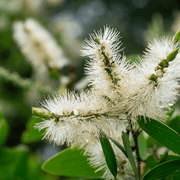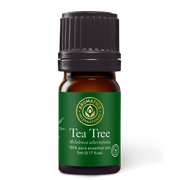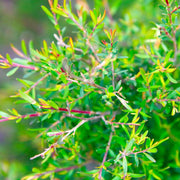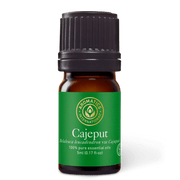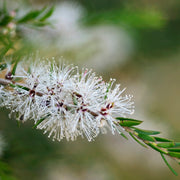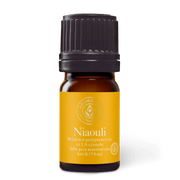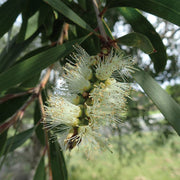In this post, you’ll learn how to use honey myrtle oil, and why its unique chemistry makes it such a potent addition to your essential oil collection!
Honey myrtle oil is a member of the Melaleuca genus from Southwest Australia. It has a scent like warm honey and lemons.
Honey myrtle is technically a shrub with small, creamy white flowers, but it can grow up to 20 feet tall.
The most famous oil from the Melaleuca genus is tea tree—a potent purifying oil that’s often used for natural cleaning and acne care—but tea tree oil is far from your only choice! You can also work with the Melaleucas rosalina, cajeput, niaouli ct. 1,8-cineole, and (of course!) honey myrtle.
Citral in honey myrtle oil: purify & soothe
When the natural components neral and geranial show up together, we call them citral.
Neral and geranial complement each other so well, they create what’s called a “synergy,” enhancing one another’s effects for super-boosted benefits! That’s why they’re often considered as one component, “citral.”
Researchers have spent a lot of time studying citral! We know it’s active against a wide array of microbes.
In fact, research is showing that honey myrtle has even more purifying properties than tea tree, all thanks to its high percentage of citral. Use honey myrtle oil in your natural cleaning blends!
Citral has also been shown to soothe soreness, aches, and discomfort, making citral-rich oils like honey myrtle helpful for muscle and joint care.
And finally, citral has an emotionally soothing presence that can help calm agitation and lift melancholy. Honey myrtle oil is a welcome addition to stress-calming body oils or diffuser blends.
Honey myrtle stands out in the Melaleuca crowd due to its citral content, a powerful combination of the chemical components neral and geranial.
β-Myrcene in honey myrtle oil: relax!
Honey myrtle oil is also high in β-myrcene.
This is a natural monoterpene molecule that can soothe soreness and discomfort. It’s also been studied for its ability to inspire relaxed, tranquil states. One 2002 study found that β-myrcene “presented sedative and motor relaxant effects” in mice (do Vale, et al. 2002).
The β-myrcene in honey myrtle oil complements the calming actions of citral.
Use honey myrtle oil safely!
Honey myrtle is a super-potent oil!
We love oils like that. It doesn’t take many drops to get profound benefits! However, it’s important to use this oil safely.
Due to its high citral content, honey myrtle might irritate skin and mucous membranes. Use a maximum dilution of 0.7% (that’s about 3 drops per 1 oz/30 ml of carrier). According to Essential Oil Safety by Tisserand and Young (second edition), pregnant women should use even less: about 0.5% on the skin (that’s about 2 drops per 1 oz/30 ml of carrier). Honey myrtle oil is also too strong for young children.
If you’re on antidepressants that inhibit the CYP2B6 enzyme, it’s best to avoid oils containing citral, including honey myrtle.
Shop honey myrtle oil
Honey Myrtle Oil (Melaleuca teretifolia)
Honey myrtle essential oil has a fresh, herbaceous, lemony aroma that likes to be noticed! A few drops go a long way. Some aromatherapists prefer this oil over tea tree for cleaning and immune protection, because it has the highest citral content of any Melaleuca oil. Our honey myrtle essential oil is steam distilled from the leaves, twigs, and soft white flowers of organically grown shrubs in Australia.







